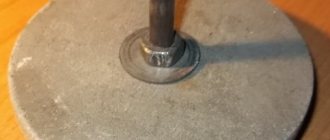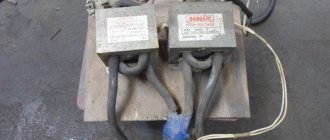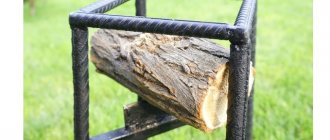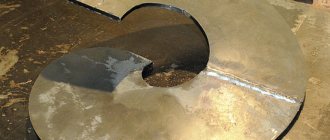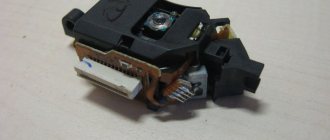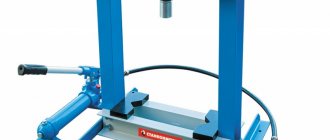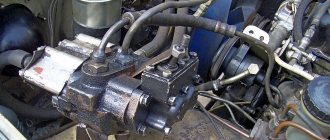Mobile conveyor for loading firewood into a trailer
Materials and tools used by the author:
List of materials:
— petrol engine 3 hp (for map or similar); — profile pipes, plates, sheet steel; — bolts, nuts, washers; - small hand winch; — ready-made conveyor belt or material for manufacturing; - matching wheels; — chain transmission; — threaded rods; - bearings in housings.
Homemade manufacturing process:
Step one. Conveyor shafts
First of all, we will make the conveyor shafts, these are the rollers on which the belt will rotate. As a base we use a round pipe of suitable diameter. The ends of the pipes need to be welded with washers; the author turned them himself on a lathe. Drill holes for the shafts in the center of the washers, insert round timber into the wheels and boil everything well. Finally, the author processed the parts on a lathe, resulting in two excellent videos. The axes will rotate on bearings in the housings.
Step three. Frame and tensioner
We assemble a frame for the conveyor; profile pipes are an excellent material for such purposes; they are relatively light and strong. The frame design is not complicated.
The frame must have a tension unit on which the driven roller is installed. This tensioning unit is a telescope in the form of pieces of pipes of different diameters, one pipe goes into the other. The telescope is fixed using screws and welded nuts. Tension occurs due to threaded rods and nuts welded into the ends of the pipes.
Step four. Lifting unit and wheels
The conveyor frame must be adjustable in angle so that firewood can be loaded into trailers of different heights. The legs are hinged to the frame in the shape of the letter “V”; at the bottom of the hinged legs there is an axle with wheels. When the legs are closed, the conveyor rises and vice versa. To adjust the conveyor, the author adapted a small hand winch.
To install the conveyor, the author also made folding legs from profile pipes; do not forget to make a trailed one for transporting the conveyor with a tractor or car.
Step five. Motor
We weld fasteners for the engine from thick sheet steel; the author used a 3-horsepower motor, such engines are used for go-karts. The motor is equipped with a centrifugal clutch and produces good torque at the output.
We also place a gas tank above the engine so that gasoline flows by gravity into the carburetor. To adjust the engine speed, we make a handle that can be locked in the desired position. Thanks to this control, you can adjust the desired conveyor speed.
Step seven. Gutter and assembly
We make a gutter for the machine; galvanized sheet steel or other sheet material is suitable here. The author bent the gutters using a sheet bending machine. We glue the resulting gutters to the frame and fasten them with a rivet gun.
After painting all the components, you can assemble the conveyor; all that remains is to install the belt on it. You can make such a tape yourself or you can buy a ready-made one.
The car is ready, you can go into the forest. The author installs the conveyor in the right place, and at the beginning of it places a stick crusher. We start the engine and set the desired belt speed. You can chop firewood and it goes straight to the trailer. Now collecting firewood has become a pleasure; you don’t have to use a chainsaw at all. With such useful machines, you can clear entire areas of branches and dead wood.
This completes the project, I hope you liked the homemade product and found useful thoughts for yourself. Good luck and creative inspiration if you decide to do this again. Don't forget to share your ideas and crafts with us!
Source
How to make a conveyor for a potato digger - Special equipment
The bulk of Russians' garden space is traditionally allocated to potatoes, because our people also call it the second bread. Many have transferred part of the labor of growing potatoes onto their shoulders, or rather onto trailed small-scale mechanization equipment: walk-behind tractors and mini tractors.
And if planting potatoes is not a big job, then hilling them, and most importantly, digging them up is not an easy task. For hilling and weeding, the hiller included with walk-behind tractors is most often used, but for digging in its pure form it is not entirely suitable. Let's figure out what to dig and how to make a potato digger for a walk-behind tractor with your own hands.
There are several known designs of potato diggers for walk-behind tractors and mini tractors. Let's look at them: from the simplest to the most technologically advanced.
Fan potato diggers
The simplest ones to manufacture are also produced industrially, but most require some modifications.
It is immediately clear that they are based on the same hiller; it is this hiller, buried below the level of the tubers, that loosens and turns the soil.
But he brings up the dug potatoes - a fan welded to the back of the hiller.
Its role is played by metal rods, welded at a distance of 3–4 cm from each other, diverging and curved in the upper part.
The amount of depth is regulated by thrust wheels, and the transverse bar serves as a footrest, upon which a person, with his weight, provides the required depth to the device.
It is this type of fan potato digger that seems to us to be the most productive. The digging process itself can be seen here:
Below is an approximate drawing of such a potato digger, containing the main parameters for manufacturing.
You will have to modify the shape, angle of attack and other nuances yourself, taking into account your soil, the power and driving performance of the walk-behind tractor on which you plan to install the potato digger, and even the varieties of potatoes that form tubers at different depths.
A type of similar digger without a fan, designed for two people:
Potato diggers with a roar
This is the most common type of potato digger, produced by various machine-building plants in Russia and abroad.
It has slight design differences, primarily in the design of the screen drive - oscillating during operation of the pan, which allows the potatoes to be partially cleared of the soil while the potato digger is moving.
The knife of such a digger can have different configurations. It can be fixed motionless, or it can be hinged and oscillate slightly during movement, simplifying the process of digging up tubers. The width of the knife is 35 – 40 cm.
DIY drawings
It is this type of potato digger, despite being quite difficult to manufacture, that is made by home craftsmen with their own hands more often than others. We offer approximate drawings with the main dimensions of such a potato digger for a walk-behind tractor.
A large number of joints of moving parts makes this device regularly serviced, but the result of its work is of better quality than that of fan-shaped potato diggers:
Potatoes are peeled better from the ground and are located on its surface.
The magnitude and frequency of oscillations of the screen may vary and depend on the design of the drive, but even with minor oscillations, cleaning occurs quite well:
Conveyor potato diggers
They are much easier to make yourself, but in our opinion they are no worse at peeling potatoes from soil.
Their knives are the same as those of the screening ones, and the potatoes are peeled while they move along the conveyor belt.
It is clear that the longer it is, the better the potatoes will be peeled, but long conveyor belts can only be installed on potato diggers used with tractors.
On walk-behind tractors, they will interfere with the person walking behind him.
The conveyor belt drive may be different. If it is taken from the wheels of the digger itself, then they must have good lugs so that they do not lock on wet or very loose soil.
Also interesting in this design are the rear guides, which more compactly place the potatoes behind the belt.
In this self-assembled conveyor potato digger, the belt drive is carried out from the power take-off shaft of a homemade walk-behind tractor and is transmitted by a motorcycle chain.
To view a picture, click on its thumbnail on the right
When manufacturing a potato digger of this type, the main problem will be selecting the rotation speed of the conveyor drive gear and matching it with the speed of the power take-off shaft.
In this model, the power take-off shaft rotates at a speed of 500 - 800 rpm, and the gearbox is taken from a motor boat with a gear ratio of approximately 1:2.
The rest is selected by the size of the stars for an approximate walking speed when digging 2-3 km/h.
There are models designed for specific walk-behind tractors and mini tractors, like this one for mechanisms with a side power take-off shaft:
Drum potato diggers
This is a rather rare type of equipment for mini-equipment, so it is mostly homemade.
Peeling potatoes from soil in such devices occurs quite efficiently, as does laying them on the ground, but the design itself is quite controversial, and the tubers are more damaged than when digging with the above-mentioned potato diggers, and therefore are worse preserved.
What is simpler about them is the direct drive of rotation from the power take-off shaft. Everything else: making the drum, thrust rollers and bearings is clearly more complicated.
The design of the knife does not have any special features, except that it is preferable for it to have a more rounded shape in the back so that the potatoes are not further damaged when they get into the drum.
Horse-mounted potato digger
There are still quite a lot of them for sale on the Internet. They are imported mainly from Poland and converted into mini tractors and walk-behind tractors.
At the same time, taking into account the higher speed of movement of this equipment in comparison with a horse, in addition to modifying the towing device, a limiter-shield is placed on it on the side on which the dug potatoes are thrown.
Otherwise, it will have to be collected in neighboring areas. A wedge-shaped paw digs up the potatoes, as in fan diggers, and the drive of the device that removes the tubers from the ground is carried out by wheels with lugs.
The higher the travel speed, the faster this potato extractor rotates.
Dear readers, if you have any questions, please ask them using the form below. We will be glad to communicate with you
We recommend other articles on the topic
How to make a potato digger with your own hands for a walk-behind tractor: video, drawings
For village residents and owners of summer cottages, the problem of harvesting crops, especially potatoes, is very close due to its labor intensity.
A small area can, of course, be dug out with a shovel, as is most often done.
However, it is much easier and faster to harvest potatoes even from two or three acres using a potato digger for a walk-behind tractor.
There is a wide selection of models of industrial potato harvesters that can be purchased in specialized stores. However, using your technical skills and our recommendations, you can make your own potato digger for a walk-behind tractor with your own hands.
Main types of potato diggers
Any potato digger is designed to loosen the soil under potato bushes and transport tubers using teeth to the surface, where they can simply be quickly collected by hand.
There are several types of potato diggers for walk-behind tractors, which you can make yourself for digging up crops in your garden:
- simple (lancet single row, fan type) - like a plow;
- vibrating, or roaring;
- conveyor type (they are also single-row);
- universal.
A simple potato digger for a walk-behind tractor is a plow to which guide rods (arrows) are welded.
When the plow cuts into the ground, the soil along with the tubers rises along the rods. In this case, the excess soil is sifted, and the tubers remain on the soil surface.
This potato digger can be installed on a mini tractor or any walk-behind tractor, for example, Neva, MTZ, Salyut.
Making a conveyor belt with your own hands
One of the main goals of business is saving on costs. How can you save money on purchasing a conveyor belt? Can you do it yourself? Let's calculate how much it will cost to make a conveyor with your own hands. Let's look at an example of manufacturing a grooved belt conveyor 5 meters long and 500 mm wide in Nizhny Novgorod. What does a conveyor belt consist of?
DIY belt conveyor video
One of the main goals of business is saving on costs. How can you save money on purchasing a conveyor belt? Can you do it yourself? Let's calculate how much it will cost to make a conveyor with your own hands. Let's look at an example of manufacturing a grooved belt conveyor 5 meters long and 500 mm wide in Nizhny Novgorod. What does a conveyor belt consist of?
Belt conveyor frame (2 bent profiles 5 m long), including hardware (let them be 3 kg). Conveyor roller supports (6 pcs) and conveyor support rollers (4 pcs). Drive and tension stations of the belt conveyor (including drive and tension drums). Conveyor belt 11 m long and connecting lock. Geared motor (let it be NMRV 063, 0.75 kW, 380V), 380V starter and 2 meters of VVG 4x1.5 cable. Now let's calculate the cost of materials and components for the conveyor belt.
The situation with roller supports is not simple - to manufacture the load-bearing support of a belt conveyor, at least 2 rollers are required, consisting of a pipe, a bearing axle and a bearing insert. To fix the axle in the roller support bracket, it is possible to use a screw fastening, which requires turning, or the use of a hexagon. In addition, there is no structural steel on the metal rolling market in Nizhny Novgorod; in order to buy it, you need to make a lot of effort. As for the frame of the roller support, its production requires 4 bent brackets, cut using laser cutting and a piece of rectangular pipe. If we add up the cost of all materials, the roller bearings will cost approximately 21,000 rubles. The cost of the material for the deflector rollers will be 4,000 rubles.
How to make a conveyor belt with your own hands
The idea of creating a conveyor belt with your own hands
- a completely realizable idea that can be operational and effective, but under one condition: you need to know the features of this type of conveyors, their vulnerabilities and the subtleties of setting operating modes. As it turns out, the most difficult processes are the processes of debugging speeds and features of the belt profile.
For what purposes is a DIY belt conveyor useful?
Any farm or production whose technological cycle involves moving bulk cargo over a distance must be provided with a conveyor belt. Such a device is inexpensive in terms of material investments, but at the same time increases labor productivity when working with building materials - crushed stone, sand, cement, products - sugar, salt, cereals, agricultural products subject to primary and secondary processing - grains, legumes, animal feed. If in large industries there is a demand for powerful factory-made installations, then in a personal household it is quite possible to get by with a belt conveyor made with your own hands and for specific parameters and products.
Where to start working on a conveyor
A conveyor belt will only work efficiently and flawlessly when its creators take into account the following parameters and conditions:
All these conditions will be decisive when developing the design and choosing materials for the conveyor belt.
What are the main parts of a belt conveyor?
Once the basic operating conditions have been determined, the selection of components for the future conveyor should begin. The conveyor includes:
Of course, you will need to perform calculations on weight loads and technological speed of the belt so that the conveyor of your own production is reliable and durable.
Features and difficulties of conveyors that you need to know about
For all its structural simplicity, a do-it-yourself belt conveyor may have a number of disadvantages that should be remembered in order to avoid them at the design and manufacturing stage:
If the task of calculating, designing, or making a belt conveyor with your own hands seems too complicated to you, contact our company for a factory-made conveyor.
How to make a conveyor belt
Conveyor belts are a special material that moves along a certain trajectory. They are intended for the movement of certain types of goods and can be of several types.
Modern conveyor belt in Ukraine is a unique opportunity to optimize production. The use of such mechanisms is very practical and is used by many enterprises.
Docking of conveyor belts: methods, materials, equipment
Conveyor mechanisms have become very widespread and are installed to transport goods and products over a certain distance.
In this case, the conveyor belt can become a platform on which the product is processed. There are three main methods of connecting conveyor belts, all of which are characterized by their own specific features.
Work on joining products is often carried out in the event of a mechanical defect or when adding sections as the length of the conveyor increases.
Docking of conveyor belts
There are various methods of joining conveyor belts that provide a high level of strength. For this, various adhesive compositions can be used. When considering common methods of connecting conveyor belts, the following points should be taken into account:
- At the time of the procedure in question, the product is subject to layer-by-layer cutting. That is why the work can only be carried out by a professional who has relevant experience.
- Some technologies are characterized by the fact that the procedure is labor-intensive, others are much simpler.
- The methods used are limited by the ambient temperature and humidity at which gluing occurs. Attention is also paid to the importance of humidity and the degree of dust in the room.
Do not forget that high joint characteristics are achieved when the required amount of time is given for the glue to dry. In most cases, polymerization occurs within 20 hours. When docking, you must follow all recommendations, since with a large mechanical impact there is a risk of rupture.
How to cold join a conveyor belt
Conveyor belts are often joined using the cold vulcanization method. This is due to the fact that the technology is quite simple, but the strength of the resulting contact when used is reduced by 25%. Cold vulcanization of conveyor belts has the following advantages:
- In most cases, there is no need to remove the belt from the conveyor mechanism.
- To carry out such technology, it is not necessary to supply a voltage of 380V. This reduces costs and significantly simplifies the procedure.
- Work on joining the product can be carried out even in a limited space. In addition, the degree of flammability of the room can be quite high.
- Quite a high speed of repairs. As practice shows, after just a few hours the operation of the device can resume.
Docking of conveyor belts when using cold technology is also characterized by a fairly large number of disadvantages, which include the following:
- Such work can only be carried out at an ambient temperature of at least 5 degrees Celsius.
- Cold vulcanization technology cannot be carried out in high humidity and heavily dusty environments.
Despite the sufficient simplification of the technology for gluing conveyor belts through the use of special adhesives, it can only be carried out by specialists. Mistakes made cause fasteners to break even under minimal load.
Hot joining of conveyor belt
On sale you can find a fairly large number of special compounds that are used to restore conveyor belts. Hot vulcanization of conveyor belts is a very common technology, since under the influence of high temperature and pressure two bases are glued together.
Synthetic and natural rubber resins have become quite widespread, which, when melted, create a reliable connection. Equipment for joining conveyor belts and special compounds make it possible to achieve strength that is 10% less than the original value. When joining using the hot vulcanization method, high strength can be achieved.
This technology is characterized by the following advantages:
- The jointing of conveyor belts allows us to achieve high strength at the joint.
- The vulcanization of the conveyor belt makes it possible to achieve uniformity of the layer at the junction.
- There is no gap at the fastening point. Due to this, the uniform movement of the product along the rollers and other fixing elements is ensured.
- It is possible to carry out the procedure even at low ambient temperatures, as well as in very dusty rooms. That is why the task is significantly simplified; hot vulcanization does not require a special room.
- High degree of flexibility of the resulting joint seam. Due to this, it is possible to install the product on a mechanism that can transport the substance along a complex trajectory.
- The procedure in question can be carried out without dismantling the equipment. That is why the task is significantly simplified and accelerated.
- It is possible to use hot joining technology for the belt, which can be used to transport a wide variety of materials.
- Durability of the resulting product. As practice shows, the technology used allows you to extend the service life several times.
- The tape can be operated at the same temperature conditions as before the joining technology.
The above information indicates that this technology has quite a lot of advantages. However, there are several serious disadvantages:
- It takes quite a lot of time to dock products.
- The procedure can only be carried out using special equipment.
The hot vulcanization method has become very widespread today. However, it is not applicable in all cases; in some cases, the mechanical method is most suitable.
Some conveyor belt connectors have become very widespread, as they can significantly simplify the procedure and speed up its implementation. However, in some cases it is possible to dismantle it. The undoubted advantage of the technology is that it does not require special equipment. To carry out such a procedure, the following is required:
- The rivet material is characterized by the fact that it can withstand very high loads.
- Hinged-rivet type is most often used on rubber-fabric and polyvinyl chloride versions.
- The one-piece bolt method is used when it is necessary to ensure a high-quality connection of transport belts.
- Hinged and bolted ones have become very widespread in cases where it is necessary to restore a product that is installed on drum equipment.
- Wire locks can be called special structural elements that are used to restore transport equipment, which is widespread in food production or warehouses.
- Staple fastenings can also be used for joining lightly loaded transport belts, which are an important part of conveyor equipment.
It should be borne in mind that the mechanical method of restoration is very common today. However, do not forget about the severe wear of the fastening element used. This is why technology is used when others cannot be used.
The mechanical method is characterized by a fairly large number of significant disadvantages:
- Reduced service life.
- Low strength at the joint.
- There is an increased degree of wear at the joint.
- Due to the use of metal elements, there is a possibility of sparks.
- When transporting hot-rolled products, there is a possibility of burning the surface at the joint.
There is also special equipment on sale that can be used to connect the product mechanically. Thanks to such tools, it is possible to carry out restoration work without dismantling.
Swivel joint um1000 11 um1750 15
This method of connecting conveyor belts has become quite widespread.
In this case, the connection is made using a special tool, which allows you to obtain a joint represented by a combination of a lock and a zipper.
The instructions for hinged connection of conveyor belts are divided into two main groups: preparation, pressing, completion of work. The preparatory stage looks like this:
- Both ends are cut at an angle of 90 degrees, for which you can use a special knife or square.
- If necessary, the top and bottom layers are removed; the recommended thickness is 15 mm.
- The number of fasteners is checked according to the width of the product. In this case, 30-40 mm are retreated from each edge.
- If two pieces of different widths are joined, then the number of connecting elements is chosen to be smaller.
- Using a measuring tool, the central part is determined.
- Do not forget that the docking starts from the center to the edges.
- Fasteners are placed in the tool, after which they are fixed.
The next step is to directly press in the fasteners used. Features include the following:
- The impact mechanism is installed in special guides.
- You should hold the device with your left hand, after which light blows are performed until the fasteners are completely seated.
After joining two elements, the edges should be cut at an angle of 30 degrees, thereby eliminating the possibility of tearing. The rod is also additionally fixed near the edge.
At the time of work, it is not recommended to use a hammer whose weight is more than 1.5 kg. This is because too much weight can cause damage to the underlying surface.
Fastening and installation with fasteners is carried out over a short period.
Plug-in connectors k20 type k27 and k28
In some cases, the joining of the conveyor belt is carried out using detachable elements, which allow for quick dismantling if necessary. For this purpose, wire staples with a special protective coating are used. Among the features of their use are the following:
- It is allowed to be used if the thickness of the product is from 8 to 13 mm.
- The required degree of strength is not higher than 1000 N/mm.
Fastening detachable connections also requires special tools, which greatly simplify the task.
Joining of conveyor belts with mechanical connections
The mechanical joining method has become very widespread. This can be related to the following:
- Easy to install.
- Wide range of applications.
- Acceptable performance characteristics.
Docking is often done in industry. In this case, a damaged tape or two whole ones may be connected to change the length.
The main advantages of mechanical connection of conveyor belts
This technology has a fairly large number of significant advantages. An example is the following:
- Low cost.
- Possibility of carrying out the procedure without dismantling the product.
- Various products can be connected.
However, there are several significant disadvantages that must also be taken into account.
Main disadvantages of mechanical connection
There are also quite a lot of disadvantages. Let's call the main ones:
- Sparks appear during operation.
- Possibility of wear of the main elements of the conveyor.
- Not applicable in all cases of operation.
- The technology does not provide the required level of plasticity at the joint.
In this case, each type of connection should be considered separately, since they are characterized by their own specific qualities.
Advantages of the locking method of docking
There are several significant advantages of using locks. Let's take the following as an example:
- Increased strength.
- Sufficient flexibility at the connection point.
- The elements used can last for a long period.
The above information indicates that such technology is often used precisely because of the large number of advantages.
In conclusion, we note that it is quite difficult to carry out docking yourself without special equipment.
That is why it is recommended to entrust the work to professionals who specialize in carrying out such work.
The special tools required for cold or hot plasticization can be found commercially. Only with proper application can you achieve your goals.
, please select a piece of text and press Ctrl+Enter.
Manufacturing methods
Conveyor belts are special elements made of rubber or metal that move in a closed circle. With their help, the process of supplying parts at various enterprises, pumping out pus on farms and many other procedures are carried out.
It is practically impossible to make such a tape yourself, since special mechanisms are required. One of the manufacturing options is the use of improvised materials, such as linoleum.
The process of installing a conveyor made from such products can be divided into several stages:
1. First, the frame is formed. To do this, they provide for attaching special transport rollers along which the tape will move. For practicality, they can be made from both metal and plastic pipes, followed by coating with rubber or other soft material. 2. After this, the tape is attached to the machine. To do this, a sheet of linoleum of the required length and width is cut out, and then put on rollers. Upon completion, the two opposite ends are combined into one.
Tape assembly process
Let's look at how to assemble a conveyor belt from standard modules. This procedure consists of several stages:
1. First, all elements are laid out on a flat surface. 2. Then the structure is mounted on the conveyor. 3. The tape is fixed both on the mechanism and in advance. There are several methods for connecting such a tape. Among them, gluing or vulcanization should be highlighted, as well as the mechanical method (using special staples, etc.).
After the tape is put on the machine, it is tensioned to a certain value and checked for functionality. Today, there are several types of such products that differ not only in strength, but also in their scope of use. It should be selected very carefully, taking into account the possible loads and type of work process.
How to join the conveyor (conveyor) belt, see the video:
Source
Conveyors
Conveyor , conveyor (from convey - to transport) is a continuous machine for moving bulk, lumpy or piece goods.
One of the ways to ensure a constant rhythmic supply of raw materials, shipment of finished products, and ensure continuity of the technological process is the use of conveyors. An important characteristic of conveyor operation is “continuity”. The conveyor as a mechanism is not a recent invention; in the past, conveyors were used by people, for example several thousand years BC. e. In ancient China and India, chain pumps were used to continuously supply water from reservoirs to irrigation systems, which can be considered prototypes of scraper conveyors. The main classification of conveyors depending on the load-carrying structure: belt, plate, cradle, scraper, bucket (elevator). There are also classifications depending on the direction of movement of objects (horizontal, inclined, etc.), depending on the traction element (screw, chain, rope). We will not list all classifications. On our website you have the opportunity to download drawings of various types of conveyors - scraper, screw, plate, belt, roller, screw and other types. In addition to drawings of the conveyors themselves, you can download drawings of their most important components. Composition: 3D Assembly, parts
Composition: Belt conveyor A1 (OV), Specification, PZ 24 sheets
Software: SolidWorks 16
Contents: 3D Assembly, drawings
Contents: 3D assembly of roller support and roller, Assembly drawing of roller support and shock-absorbing roller, 3D models of parts, Specification
Contents: 3D assembly of roller support and roller, Assembly drawing of support roller and roller, 3D drawings of parts, Specifications
Software: SolidWorks 2012
Composition: 3D Model of the Tensioning station of a chain traction conveyor.
Software: SolidWorks 2012
Composition: 3D model of the assembly of the drive sprocket of a traction conveyor with a plate traction chain used. 3, pitch 125mm GOST 588.
Software: SolidWorks 2017
Composition: The graphic part of the course project includes: 1) Plate conveyor (general view drawing) – 1 sheet A1; 2) Specification “Plate conveyor” – 1 A4 sheet; 3) Drive station (general view drawing) – 1 sheet A1; 4) Specification “Drive station” – 3 sheets of A4; 5) Tension station (general view drawing) – 1 sheet A1; 6) Specification “Tension station” – 2 A4 sheets; 7) Chassis (general view drawing) – 1 sheet A1; Specification “Chassis” – 1 sheet A4; 9) Loading hopper (general view drawing) – 1 sheet A1; 10) Specification “Loading hopper” – 2 A4 sheets.
2) Specification “Plate conveyor” – 1 A4 sheet; 3) Drive station (general view drawing) – 1 sheet A1; 4) Specification “Drive station” – 3 sheets of A4; 5) Tension station (general view drawing) – 1 sheet A1; 6) Specification “Tension station” – 2 A4 sheets; 7) Chassis (general view drawing) – 1 sheet A1; Specification “Chassis” – 1 sheet A4; 9) Loading hopper (general view drawing) – 1 sheet A1; 10) Specification “Loading hopper” – 2 A4 sheets.
Software: KOMPAS-3D 16 SP1
Composition: Selection of mine transport (PZ), Transport schemes, Design of linings for drive drums of mine belt conveyors (SB)
Contents: 3d model with details, drawings
Software: KOMPAS-3D 3D V16
Contents: Assembly drawing, Detailing, 3D models
Contents: General view drawing, with overall and connection dimensions
Composition: Plate conveyor (general view drawing) – 1 sheet of A1 format; Drive station (general view drawing) – 1 sheet of A1 format; Tension station (general view drawing) – 1 sheet of A1 format; Flooring with traction element (general view drawing) – 1 sheet of A1 format; Loading device (general view drawing) – 1 sheet of A1 format; PZ
Contents: Assembly drawing (AS) in A2 format, specification
Source
